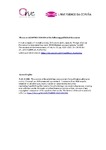Mostrar o rexistro simple do ítem
Design of Linear Precoders for Correlated Sources in MIMO Multiple Access Channels
| dc.contributor.author | Suárez-Casal, Pedro | |
| dc.contributor.author | González-Coma, José P. | |
| dc.contributor.author | Fresnedo, Óscar | |
| dc.contributor.author | Castedo, Luis | |
| dc.date.accessioned | 2023-12-19T15:19:23Z | |
| dc.date.available | 2023-12-19T15:19:23Z | |
| dc.date.issued | 2018-12 | |
| dc.identifier.citation | P. Suárez-Casal, J. P. González-Coma, Ó. Fresnedo and L. Castedo, "Design of Linear Precoders for Correlated Sources in MIMO Multiple Access Channels," in IEEE Transactions on Communications, vol. 66, no. 12, pp. 6110-6122, Dec. 2018, doi: 10.1109/TCOMM.2018.2863362. | es_ES |
| dc.identifier.issn | 0090-6778 | |
| dc.identifier.uri | http://hdl.handle.net/2183/34552 | |
| dc.description | © 2018 IEEE. This version of the article has been accepted for publication, after peer review. Personal use of this material is permitted. Permission from IEEE must be obtained for all other uses, in any current or future media, including reprinting/republishing this material for advertising or promotional purposes, creating new collective works, for resale or redistribution to servers or lists, or reuse of any copyrighted component of this work in other works. The Version of Record is available online at: https://doi.org/10.1109/TCOMM.2018.2863362 | es_ES |
| dc.description.abstract | [Abstract]: This paper focuses on distributed linear precoding when users transmit correlated information over a fading multiple-input and multiple-output multiple access channel. The precoders are optimized in order to minimize the sum-mean square error (MSE) between the source and the estimated symbols. When sources are correlated, minimizing the sum-MSE results in a non-convex optimization problem. The precoders for an arbitrary number of users and transmit and receive antennas are thus obtained via a projected steepest-descent algorithm and a low-complexity heuristic approach. For the more restrictive case of two single-antenna users, a closed-form expression for the minimum sum-MSE precoders is derived. Moreover, for the scenario with a single receive antenna and any number of users, a solution is obtained by means of a semi-definite relaxation. Finally, we also consider precoding schemes where the precoders are decomposed into complex scalars and unit norm vectors. Simulation results show a significant improvement when source correlation is exploited at precoding, especially for low signal-to-noise ratios and when the number of receive antennas is lower than the number of transmitting nodes. | es_ES |
| dc.description.sponsorship | This work has been funded by Office of Naval Research Global of United States (N62909-15-1-2014), the Xunta de Galicia (ED431C 2016-045, ED341D R2016/012, ED431G/01), the Agencia Estatal de Investigación of Spain (TEC2015-69648-REDC, TEC2016-75067-C4-1-R) and ERDF funds of the EU (AEI/FEDER, UE). | es_ES |
| dc.description.sponsorship | United States. Office of Naval Research Global of United States; N62909-15-1-2014 | es_ES |
| dc.description.sponsorship | Xunta de Galicia; ED431C 2016-045 | es_ES |
| dc.description.sponsorship | Xunta de Galicia; ED341D R2016/012 | es_ES |
| dc.description.sponsorship | Xunta de Galicia; ED431G/01 | es_ES |
| dc.language.iso | eng | es_ES |
| dc.publisher | Institute of Electrical and Electronics Engineers | es_ES |
| dc.relation | info:eu-repo/grantAgreement/MINECO/Plan Estatal de Investigación Científica y Técnica y de Innovación 2013-2016/TEC2015-69648-REDC/ES/RED COMONSENS | es_ES |
| dc.relation | info:eu-repo/grantAgreement/AEI/Plan Estatal de Investigación Científica y Técnica y de Innovación 2013-2016/TEC2016-75067-C4-1-R/ES/CODIFICACIÓN Y PROCESADO DE SEÑALES PARA REDES EMERGENTES DE COMUNICACIÓN Y DE SENSORES INALÁMBRICAS | es_ES |
| dc.relation.isversionof | https://doi.org/10.1109/TCOMM.2018.2863362. | |
| dc.relation.uri | https://doi.org/10.1109/TCOMM.2018.2863362. | es_ES |
| dc.rights | ©2018 IEEE | es_ES |
| dc.rights | Todos os dereitos reservados. All rights reserved. | es_ES |
| dc.subject | Correlation | es_ES |
| dc.subject | Multiuser channel | es_ES |
| dc.subject | Linear approximation | es_ES |
| dc.subject | Optimization methods | es_ES |
| dc.subject | Transmitters | es_ES |
| dc.title | Design of Linear Precoders for Correlated Sources in MIMO Multiple Access Channels | es_ES |
| dc.type | info:eu-repo/semantics/article | es_ES |
| dc.rights.access | info:eu-repo/semantics/openAccess | es_ES |
| UDC.journalTitle | IEEE Transactions on Communications | es_ES |
| UDC.volume | 66 | es_ES |
| UDC.issue | 12 | es_ES |
| UDC.startPage | 6110 | es_ES |
| UDC.endPage | 6122 | es_ES |
| dc.identifier.doi | 10.1109/TCOMM.2018.2863362 |
Ficheiros no ítem
Este ítem aparece na(s) seguinte(s) colección(s)
-
GI-GTEC - Artigos [190]






